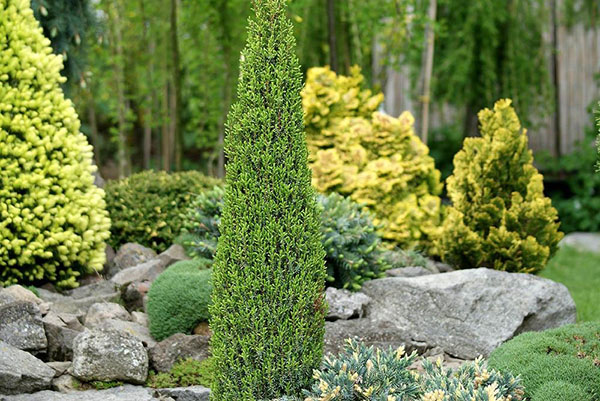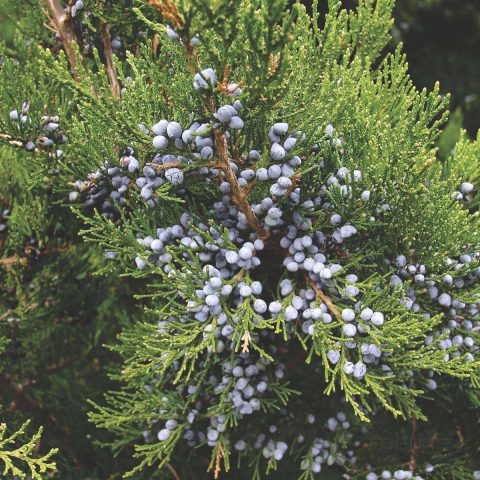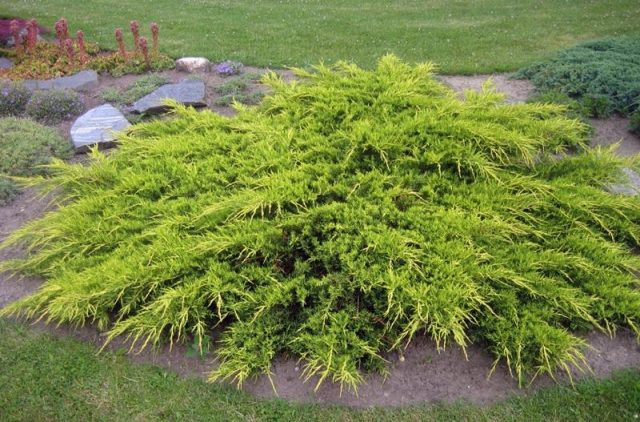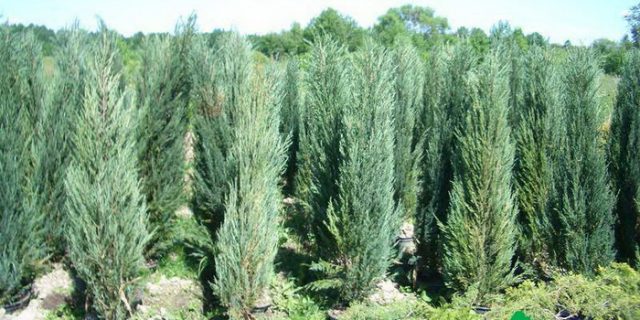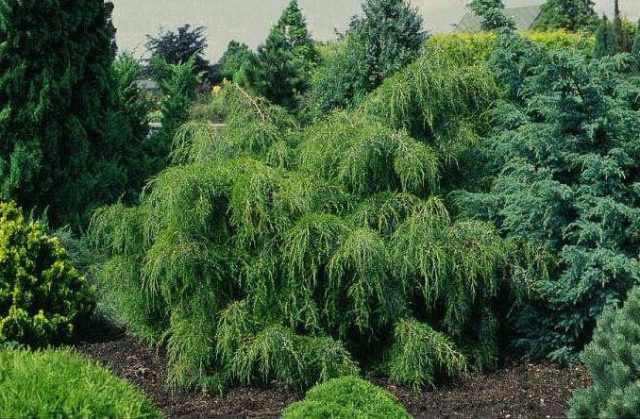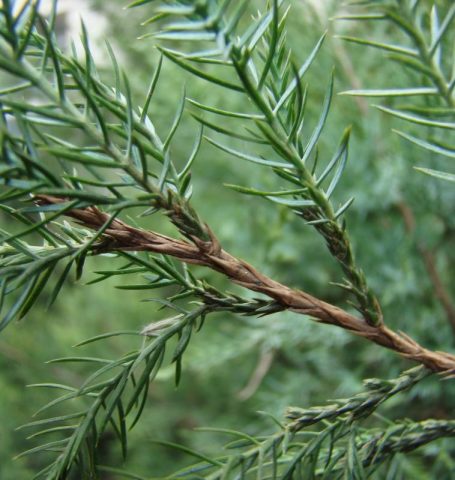Content
For several millennia, people have been using junipers to decorate gardens and the space around their homes. This is an evergreen, picky coniferous plant. Juniper Virginia (Virginia) - one of these varieties, a representative of the genus Cypress. Designers use the plant for landscaping due to the wide variety of colors, shapes and sizes of this crop. The article presents a photo and description of the Virginia juniper, as well as the basic rules for growing a plant.
Description of virginian juniper
Juniper virginiana (Latin Juniperus virginiana) is an evergreen, usually monoecious shrub of the Juniper genus. The habitat of the plant is North America, from Canada to Florida. The tree can be found on rocky shores and a little less often in swampy areas.
Over time, fruits appear on the juniper - pineal berries of a dark blue color, which remain on the branches until the onset of severe frosts.
The plant has a developed root system with lateral shoots, which helps it easily withstand gusts of wind.
The tree is characterized by small needle-shaped or scaly needles (1 - 2 mm in length). The color of the needles fluctuates between dark green and bluish-green shades, and in winter the plant's cover takes on a brown color.
Virginia juniper has a resinous coniferous aroma that can purify the air of various bacteria. The smell of juniper is believed to help restore mental balance, find peace, as well as relieve headaches and improve sleep.
For the first time specimens of Virginia juniper were presented in the 17th century in America, and in the first quarter of the 19th century tree sprouts were brought to the territory of Russia. The most unique varieties of plants are in the Botanical Institute and the Forestry Academy. Among other varieties, it is this culture that has the most pronounced decorative properties.
Sizes of virginian juniper
Juniper Virginia is considered a rather tall plant: the tree can reach up to 30 m in height. The diameter of the trunk of the Virginia juniper is on average 150 cm, and the diameter of the crown is 2.5 - 3 m. In the early stages of growth, the crown of the plant has a narrow ovoid shape, which over time becomes wider and more voluminous, acquiring a columnar shape. Juniper Virginia can completely occupy an area of 10 m2.
Rates of growth
Juniper Virginia is characterized by rapid growth - on average, 20 - 30 cm per year.Everything also depends on the type of tree: for example, the indicators of the annual growth of the Skyrocket variety are 20 cm in height and 5 cm in width, the Glauka varieties - 25 cm in height and 10 cm in width, and the Hetz varieties - up to 30 and 15 cm, respectively.
Winter hardiness zone of virginian juniper
Almost all varieties of Virginia juniper are characterized by a high level of winter hardiness: even the most severe frosts do not affect their condition and appearance. However, columnar (Blue Arrow, Glauka, Skyrocket) and narrow pyramidal (Canaherty, Hetz) tree forms can be negatively affected by snowfalls. To prevent this from happening, in winter, the branches of the plant must be tied tightly.
Juniper virginiana in landscape design
Virginia junipers are very popular in the field of landscape design due to a huge variety of shapes, sizes and colors, as well as due to their unique decorative properties. The growth rate of plants is average, they are unpretentious to growing conditions and are easily adaptable to cutting.
Landscape designers actively use virgin junipers to decorate gardens: they go well with both conifers and deciduous flowers, trees and shrubs.
Moreover, the Virginia juniper has an irreplaceable quality for landscape decoration: it is an evergreen plant, the appearance of which remains unchanged at any time of the year.
It is best to purchase Virginia juniper to decorate the territory in special nurseries, where all detailed information about the plant and the rules for caring for it will be available.
Virginia juniper varieties
On average, there are more than 70 varieties of Virginia juniper, most of which are actively grown in Russia. The shape, size and color of each variety is varied and unique, which makes it possible to use the shrub to create decorative compositions.
Almost all plant varieties recover quickly after shearing and shaping.
Juniper Virginia Canaerty
Juniper Virginiana Kanaerti (Juniperus virginiana Сanaertii) is the most popular representative of the columnar or pyramidal forms with upward branches. The shoots of the tree are short, with the ends hanging down. At 30 years old, it reaches more than 5 meters in height. Young shoots of the tree have green scaly needles, which acquire an acicular shape with age. The fruits of the plant are large, with a blue-white color.
Variety Kanaerti is a light-loving plant (the tree tolerates shade only at a young age), capable of growing on almost any soil.
Juniper Virginia Glauka
Juniper Virginia Glauca (Juniperus fastigiata Glauca) is a slender tree 5 - 6 m high with a narrow conical or columnar crown shape, the diameter of which is 2 - 2.5 m. The growth rate of the plant is fast, up to about 20 cm per year.
The juniper of Virginia Glauka is characterized by thick shoots that grow evenly. The branches of the tree are directed upward, forming an acute angle with the trunk. Over time, the crown of the juniper gradually becomes loose.
The Glauka variety has small, blue-green needles, which become bronze with the onset of frost. On the branches of juniper, you can see a large number of fruits - rounded cones of a whitish-gray color, the diameter of which is 0.6 cm.
So that the plant does not lose its rich color, it is recommended to grow the tree in sunlit areas without stagnation of moisture in the soil. The Glauka variety also has a high level of winter hardiness, it is undemanding to the planting soil.
The main advantage of this variety is considered to be quick adaptability to cutting and shaping. Landscape designers actively use the plant as a tapeworm on the lawn, as well as for decorating walking alleys and creating hedges.
Juniper Virginia Golden Spring
Juniper Virginia Golden Spring (Golden Spring) is an evergreen dwarf shrub with a spreading, cushion-shaped crown. The shoots of the plant are located at an angle, which is why the crown takes the shape of a hemisphere. The juniper has scaly needles of a golden hue, which eventually acquire a bright green color. The Golden Spring variety is not picky about the soil, it shows its decorative qualities best in sunny planting places.
Before planting shrubs, it is important to lay a drainage layer of sand and broken brick on the bottom of the planting pit.
Juniper Gold Spring needs moderate watering and sprinkling during the hot season. It is also resistant to cold and severe frost.
Juniper Virginia Skyrocket
Juniper Virginia Skyrocket is a tall - about 8 m - plant with a dense columnar crown, 0.5 - 1 m in diameter. The shrub grows upward, with an increase of 20 cm per year. Plant growth in width is insignificant: 3 - 5 cm per year.
Juniper branches, close to the trunk, extend upward. The Skyrocket variety is characterized by tough, scaly, bluish-green needles, as well as round, bluish-colored fruits.
Juniper Skyrocket has a tap root system, which significantly increases the level of wind resistance of the plant. It does not tolerate shaded areas, grows well and develops only in sunny areas, is resistant to gas pollution in large cities, and has a high level of tolerance to cold and frost.
Juniper Virginia Pendula
Juniper Pendula (Pendula) has a serpentine curved trunk, and in some cases - 2 - 3 trunks. The tree of this variety has thin skeletal branches that grow unevenly in different directions, bend in an arc to the side of the trunk, and then hang down sharply. The height of an adult plant is about 2 m, and the diameter of the crown is 1.5 - 3 m. Young juniper needles have a green, slightly bluish tint, and with age they acquire a rich bright green color. The fruits of the Pendula variety are round in shape, 5 - 8 mm in diameter.
Young cone berries can be identified by their light green color, while ripe berries acquire a blue tint with a bluish waxy bloom. The most optimal planting site for a plant is sunny places with little access to shade. It germinates well on breathable fertile soil without moisture stagnation. It is actively used to create single or group plantings in parks, squares and gardens. Often, the Pendula variety can be found as a hedge.
Juniper Virginia Tripartite
Juniper Virginia varieties Tripartita (Tripartita) - a low shrub with a voluminous dense spreading crown. Plant height in adulthood is 3 m with a crown diameter of 1 m.This variety is characterized by a rapid growth rate in width (with an annual increase of up to 20 cm), which is why the shrub needs room for normal growth and development. The shrub is characterized by scaly and needle-shaped needles of green color.
The fruits of the Tripartite variety are round, fleshy blue-gray poisonous cones.
The shrub actively grows and develops in lightened areas, tolerates partial shade well, as well as severe frosts in winter.
It is used both for decorating conifers and mixed groups, and for single planting on the lawn.
Juniper Virginia Gray Owl
Juniper Virginia Gray Oul (Gray Owl) is an evergreen low-growing shrub with a flat spreading crown.
The height of an adult plant is 2 - 3 m, with a crown diameter of 5 to 7 m. It has an average growth rate with an annual growth of ten centimeters in height and twenty centimeters in width. The branches are horizontal, they are slightly raised.At the base of the branches there are needle-like needles, and at the ends of the shoots - scaly, gray-blue or greenish. The length of the needles is 0.7 cm.
The shrub recovers well even after a plentiful haircut, tolerates a hot period well with regular spraying.
Juniper Virginiana Helle
Young shrubs of the Helle variety have a columnar crown shape, which becomes wide-pyramidal with age.
An adult plant grows to about 6 - 7 m in height. Juniper needles are acicular, with a rich green color.
It is undemanding to the planting site, it develops well in moderately nutrient-rich soil. Among all the varieties of juniper, the Virginian variety Hele is characterized by almost the highest level of frost resistance.
Juniper Virginia Blue Cloud
Juniper Virginia Blue Cloud is a perennial plant, one of the most popular varieties in Russia due to its high level of frost resistance. The needles are scaly, with a bluish-gray tint. The culture is undemanding to lighting, it develops well both in sunny and shaded areas. The crown has a spreading shape. The annual growth of Virginia Blue Cloud juniper is 10 cm.
When transplanting to shrubs, it is especially important to provide a slightly moist soil, as the development of a plant in too moist soil can be significantly impaired.
The planting soil for the Blue Cloud variety should be saturated with peat.
Juniper Virginiana Spartan
Juniper Virginsky Spartan (Spartan) is an ornamental coniferous shrub with a columnar, candle-shaped crown shape. An adult plant reaches a height of 3 to 5 m, and a width of up to 1.2 m. It is characterized by a slow growth rate with an annual increase of up to 17 cm in height and up to 4 cm in breadth. The needles of the plant are soft, with a light green tint. Shoots are arranged vertically.
The variety is undemanding to the soil, planting can be done on any fertile soil - both acidic and alkaline. The shrub develops better in sunny places, tolerates light shading. It is used in single and group plantings, hedges, as well as in combination with roses - to decorate alpine slides.
The culture prefers sunny areas, tolerates a little shading. Suitable for planting in single and group plantings, as hedges, decorates alpine slides and looks great with roses.
You can find out more information about the varieties of juniper virginiana and the main rules of care from the video:
Planting and caring for virgin juniper
Juniper Virginia is a rather picky plant. However, growing even such an easy-to-maintain shrub, it is important to remember the main rules for care.
Seedling and planting plot preparation
The best option would be to purchase young seedlings in containers. Transplanting an adult shrub will require professional gardening skills.
Juniper virginiana is often grown in the ground, and digging is carried out along with an earthen clod for sale. Container-grown plants are also sold.
The most optimal period for planting a plant will be spring (April-May) and autumn (October). If the seedlings have a closed root system, they can be transplanted at any time of the year, it is only important to shade the area and provide the plant with regular watering.
For the light-loving Virginia juniper, the best option would be a spacious, well-lit place with loamy or sandy loamy soil saturated with nutrients. If the soil is clayey and heavy, a special mixture of garden soil, sand, peat and coniferous soil is added to the pit. Before planting a shrub, it is necessary to drain the earth, covering the bottom of the planting pit with broken brick or sand.Juniperus virginiana tolerates the dry period well, however, stagnant moisture in the ground can be detrimental to the plant.
You should not plant a shrub next to climbing flowers, as this can seriously affect its condition: the plant will lose its decorative qualities, gradually turn into painful and lethargic.
After planting, mulching of the soil should be carried out near the trunk with the addition of wood shavings from other conifers, as well as watering the plant at the very root.
Landing rules
The composition of the soil mixture for planting Virginia juniper:
- 2 parts of sod land;
- 2 parts of humus;
- 2 parts of peat;
- 1 part sand.
150-200 g of Kemira-wagon and 250-300 g of Nitrofoski should also be added to the soil for active growth of the shrub.
The size of the planting pit directly depends on the size of the seedling itself, and its depth is approximately 2 - 3 shovel bayonets. These parameters are also influenced by the size of the root system: for medium species, the size of the pit can be 40 by 60 cm, and for larger ones - 60 by 80, respectively. It is necessary to plant the shrub quickly in order to prevent the roots from drying out, but very carefully so as not to harm the young roots. After planting a juniper in open soil, the plant should be watered abundantly and protected from direct sunlight. The density of planting is influenced by the type of landscape composition, and the plants themselves should be from 0.5 to 2 m apart.
Watering and feeding
It is very important to provide young seedlings of Virginia juniper with regular but moderate watering. Adult plants tolerate drought much better: they should be watered infrequently, depending on the heat (2 - 4 times a month).
In the hot season, you need to spray the plant: 2 times in 10 days, in the evening and in the morning. From April to May, a dose of Nitroammofoska should be applied under each shrub: 35 - 40 g per 1 sq. m.
After planting, the soil around the tree should be fertilized with peat, wood chips or pine bark. Fertilizing is best at the initial stage of the growing season (April-May). It is recommended to feed the soil from time to time with Kemira-universal (20 g per 10 l).
Mulching and loosening
Periodically, it is necessary to carry out shallow loosening of the earth around the trunk of a juniper and remove all weeds.
Loosening and mulching of the soil around young seedlings should be carried out immediately after watering and removing all weeds. Mulching with peat, wood chips or sawdust (layer 5 - 8 cm) is carried out immediately after planting, and for especially thermophilic varieties - in winter.
Juniper pruning
Pruning of virginian juniper is usually carried out when creating a hedge or other landscape compositions; in natural conditions, the plant does not need to be pruned.
Gardeners also use pruning shrubs to give them a fuller crown, but caution should be exercised here: one wrong movement can degrade the appearance of the plant for a long time.
Once every few months, you can carefully trim the protruding ends of the broken branches.
Preparing for winter
In winter, the crown of a juniper can sag under the strong pressure of snow covers. To prevent this from happening, the crown of the tree must be tied tightly in the fall. Some varieties of Virginia juniper are sensitive to daily spring temperature fluctuations in temperature, therefore, by the end of February, they need protection from intense sun.
Sunburn leads to the appearance of a brownish-yellow shade of the needles and the loss of decorative characteristics. So that the needles of the plant do not lose their brightness in the winter, it must be properly watered, fertilized in the spring and regularly sprayed with micronutrient fertilizers.
Among all the options for sheltering a juniper, the following can be distinguished:
- Throwing snow over the branches of the ephedra.The method is well suited for miniature and creeping forms.
- Lapnik, fixed on the branches of a plant in the form of tiers.
- Woven or non-woven fabrics. Gardeners wrap the plant in burlap, two layers of craft paper, light-colored cotton cloth and fasten it with a rope without covering the bottom of the crown.
- Screen. It must be installed on the most illuminated side of the bush.
Reproduction of the virginian juniper Juniperus Virginiana
Sometimes it is quite problematic to get decorative forms of a shrub using seeds. This is due to the fact that not all seeds can germinate.
Cuttings
Gardeners recommend using the variant of reproduction of Virginia juniper by cuttings: in the spring they are cut 5 - 8 cm from the young shoots of the plant, each of them contains up to 2 internodes and a small fragment of the bark of the mother branch. Planting material must be pre-treated with a rooting stimulator.
Planting is carried out in soil mixed with peat, humus and sand in equal parts. From above, the soil is sprinkled with coarse sand up to 5 cm. A glass container is used as a shelter for each cutting. The stalk is planted to a depth of 1.5 - 2 cm.
The root system of the plant begins to develop in the fall, it is grown for another 1 - 1.5 years before being transplanted to a permanent place.
From seed
Before germinating the seeds of juniper virginiana shrubs, they must be cold treated for a faster growth rate. The seeds are placed in boxes with soil mixture and taken out into the street for storage up to 5 months. Seeds are sown in the beds since May.
In some species of Virginia juniper, the seeds have a fairly dense shell. Their germination can be accelerated by acting on the shell of an acid or by mechanically disrupting its structure. For example, the seeds are rubbed between two boards entwined with emery material, after which they are placed in the ground 3 to 4 cm.Care for crops is quite simple: it is necessary to mulch the beds, ensure regular watering and protection from active sun in the first one and a half to two weeks. When the seedlings are 3 years old, they are allowed to be transplanted to a permanent place.
Diseases and pests
The most common disease for juniper virginiana is a fungal disease, due to which spindle-shaped thickenings appear on parts of the plant, the root collar swells, the bark dries and crumbles, forming open wounds. The branches affected by the diseases die off over time, the needles turn brown and quickly crumble. In the later stages of the disease, the shrub dies.
If a juniper is affected by a fungal disease, it is necessary to immediately cut off all infected branches and disinfect open wounds with a 1% solution of ferrous sulfate and cover with garden varnish. The cut branches must be burned.
In addition to fungal disease, juniper virginiana may suffer from bark necrosis or alternaria, however, the method of treating such diseases is completely identical.
The main pests of juniper virginiana are moths, aphids, spider mites and scale insects. Spraying the bush, which can be purchased at specialized stores, will help to protect the plant.
Conclusion
The photo and description of the Virginia juniper testifies to the high decorativeness of culture, thanks to which it is actively used by designers to decorate the territory and create landscape compositions. The plant is unpretentious in care, has a high level of winter hardiness and is ready to delight with its beauty for a long time. It is important to remember the main rules for keeping a shrub, to provide it with proper watering and regular prevention: then the juniper will be able to thank you with its beauty and long growth.

